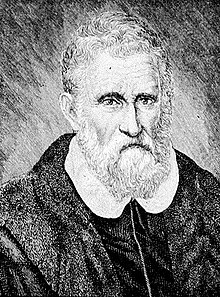Marco Polo
| Marco Polo | |
|---|---|
 Portrait of Marco Polo[Note 1] | |
| Ọjọ́ìbí | c. 1254 Venice, Venetian Republic |
| Aláìsí | January 8, 1324 (ọmọ ọdún 69) Venice, Venetian Republic |
| Resting place | Church of San Lorenzo 45°15′41″N 12°12′15″E / 45.2613°N 12.2043°E |
| Orílẹ̀-èdè | Venetian (Italian) |
| Iṣẹ́ | Merchant, Explorer |
| Gbajúmọ̀ fún | The Travels of Marco Polo |
| Olólùfẹ́ | Danta Badoer |
| Àwọn ọmọ | Fantina, Bellela, and Moretta |
| Parent(s) | Mother: Unknown Father: Niccolò Polo |
Marco Polo (![]() /ˈmɑrkoʊ ˈpoʊloʊ/; Àdàkọ:IPA-it; c. 1254 – January 9, 1324)[1] was a Venetian merchant traveler[2][3] from the Venetian Republic whose travels are recorded in Il Milione, a book which did much to introduce Europeans to Central Asia and China. He learned about trading whilst his father and uncle, Niccolò and Maffeo, travelled through Asia and apparently met Kublai Khan.
/ˈmɑrkoʊ ˈpoʊloʊ/; Àdàkọ:IPA-it; c. 1254 – January 9, 1324)[1] was a Venetian merchant traveler[2][3] from the Venetian Republic whose travels are recorded in Il Milione, a book which did much to introduce Europeans to Central Asia and China. He learned about trading whilst his father and uncle, Niccolò and Maffeo, travelled through Asia and apparently met Kublai Khan.

|
Àyọkà yìí tàbí apá rẹ̀ únfẹ́ àtúnṣe sí. Ẹ le fẹ̀ jù báyìí lọ tàbí kí ẹ ṣàtúnṣe rẹ̀ lọ́nà tí yíò mu kúnrẹ́rẹ́. Ẹ ran Wikipedia lọ́wọ́ láti fẹ̀ẹ́ jù báyìí lọ. |
Itokasi[àtúnṣe | àtúnṣe àmìọ̀rọ̀]
- ↑ The exact source is unknown, but the portrait originated from a 16th century painting in the Gallery of Monsignor Badia in Rome. Inscription: Marcus Polus venetus totius orbis et Indie peregrator primus. It appears in the Nordisk familjebok Berg 1915, p. 1261
